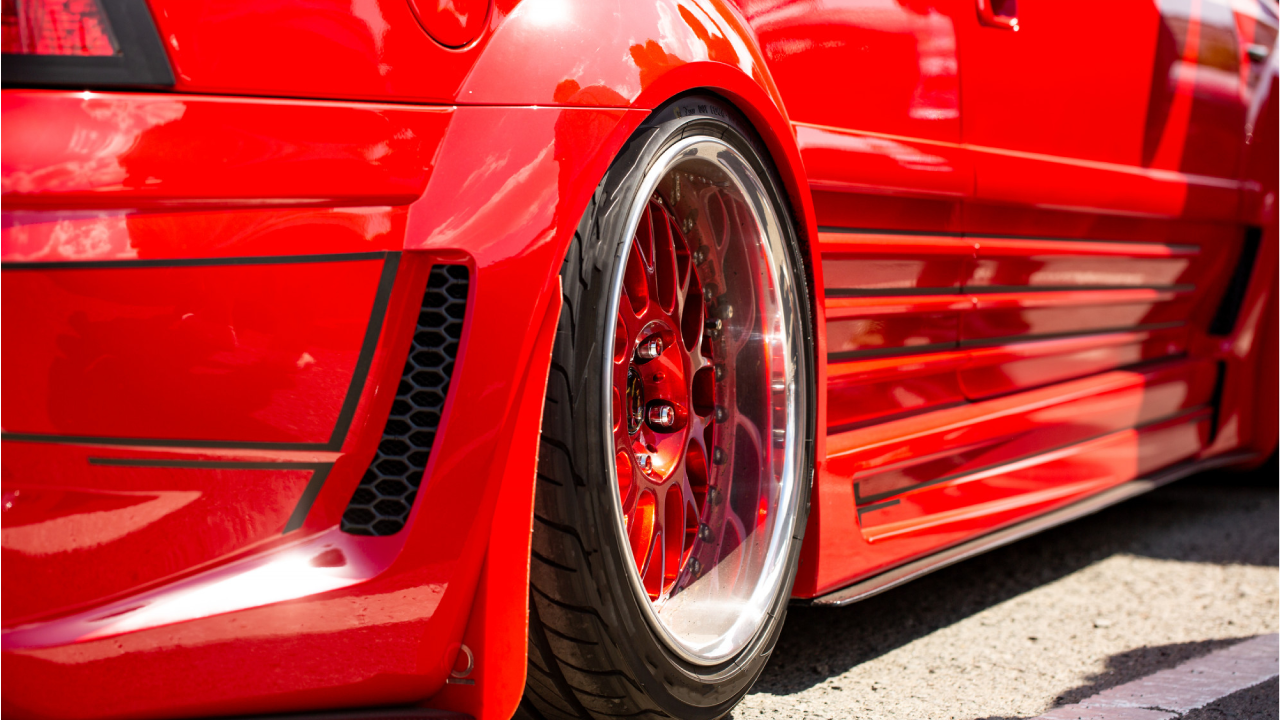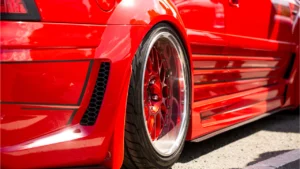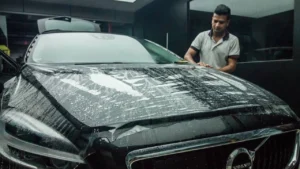So, you’ve been wondering if getting your car repainted in its old colour will bring back its shine and glory or if there is a long-term colour maintenance option. It’s a common dilemma for many car owners who notice fading, scratches or dents on their beloved vehicles. While repainting can certainly give your car a fresh look, it’s not always the most practical or cost-effective solution.
In this blog, we’ll explore the pros and cons of repainting and introduce you to proven alternatives that can restore your car’s appearance without you having to spend a large sum of money. We’ll discuss the benefits of detailing, ceramic coatings and paint protection film (PPF) and help you decide which option is best for your car.
Table of contents
Reasons to repaint a car
Yes, we know repainting can certainly give your car a brand-new look. But, for how long, that’s subjective. It is important to look at the reasons that might drive you to this decision.

Accident Damage
Fading or Discolouration
Over time, exposure to sunlight, rain and harsh chemicals can cause your car’s paint to fade or discolour.
Rusting
If your car is constantly exposed to moisture, rust can develop. Repainting is a common solution to address this issue.
Personal Choice
Sometimes, you simply want a change! A new coat of paint can give your car a fresh, personalised look that reflects your style.
Why repainting might not be a good idea
It’s important to weigh the costs and potential drawbacks before deciding to repaint the car. Here are some reasons why repainting might not be the best option:
Value For Money
While repainting a car might sound like an easy way out, it could cost a bomb and is not a viable investment when the cars involved are luxury vehicles. Repainting large sedans, luxury SUVs and sports cars can cost anywhere upward of ₹1,00,000. Apart from the extent of work, acquiring special paint colours, like the Python Green of Lamborghini or the District Green Metallic of Audi can increase the costs.
Time-Consuming
The repainting process can be time-consuming. You can expect your car to be in the shop for at least a week. This depends on several factors including the prepping phase, the application process, vehicle size and the level of correction required.
Potential for Damage
During the repainting process, there is always a risk of damage to other parts of your car. This can include scratches, dents or even electrical issues if not handled carefully or by experts.
Loss of Original Paint Quality
Repainting a vehicle, even with high-quality materials and skilled technicians, can never fully replicate the original factory finish. This is because the original paint job is applied under controlled conditions during the manufacturing process, ensuring optimal adhesion, colour accuracy and durability. A repaint, on the other hand, is typically done in a workshop, where factors like temperature, humidity and surface preparation can influence the final result.
Negative Impact on Resale Value
Repainting your car can improve its cosmetic appeal but may not substantially increase its resale value. In fact, repainting can indicate that the vehicle is not in its original condition, which could negatively impact potential buyers. The cost of a professional paint job might outweigh any perceived financial gains, especially if the vehicle is already several years old.
An alternative solution - Car Detailing and Paint Correction
Car detailing and paint correction or refinement is a comprehensive cleaning and restoration process that goes beyond a basic wash. By removing swirls, scratches, fading and other imperfections, a car’s paint can look as good as new.
While car detailing involves deep cleaning, targeting both the exterior and interior of the vehicle, paint correction or refinement is a crucial part of it as a comprehensive process to restore its paint to its near-original condition.
The process typically involves a degreaser wash, where a specialised degreasing and foaming agent is used to thoroughly remove grease, pollutants and dirt from the car’s paint surface. Then a clay bar is used to remove sticky contaminants and debris that may not go away during a regular wash. This ensures a smooth and bump-free surface.

The clear coat is then carefully sanded to remove scratches and other paint defects. Detailers carefully monitor the thickness of the paint and clear coat to avoid damaging the underlying layers. And then a compound, along with a machine and pad, is used to remove minor paint defects and sanding marks.
This is then finished off with polishing to restore the paint surface’s smoothness and shine. A thorough detailing job can remove dirt, grime and contaminants, including stubborn stains, bird droppings and tree sap, which could cause irreparable damage to the paint.
Reactionary Step vs Precautionary Measure
A repainting job is a step taken after the car’s paint and body have seen significant damage and now require something to fix and hide the flaws. Repainting may sound like a less expensive option than detailing, but the cost can be a recurring one every few years, depending on the extent of usage and the type of paint used. Repainting is also a lengthy process, often taking several days or weeks to complete.
It is also important to consider which kind of vehicle is worth repainting. For instance, a Maruti Alto or a Hyundai i20 hatchback that has seen its glory days can be repainted, as it won’t cost a bomb given its size, and lifetime usage. But when it comes to cars from the premium segment like a Jaguar F-Pace, a Land Rover Defender or even a Mahindra Scorpio N Z8, car paint protection from day one is a must.
This is where car PPF comes into the picture as a precautionary measure to prevent heartache from a dull car in the future. PPF on cars is usually made with thermoplastic polyurethane (TPU), which prevents scratches, abrasions, chemical reactions and corrosion from damaging your car’s paint. It acts as a sacrificial layer which takes all the brunt from the exposure to environmental elements and other damages caused by humans like door dings, key scratches, bad parking, etc.

Aegis PPF by CarzSpa stands out as the best PPF for cars in the market because of the innovative addition of Polycarbonate to the TPU and the new generation DuroFlex top coat which provides improved scratch resistance, self-healing and added shine.
But what makes this the best alternative to repainting?
PPF offers a superior solution to maintaining your car’s pristine condition, especially for high-end vehicles like a Mercedes or a BMW and those with sentimental value like the classic Honda City or even the old Jeeps. Compared to repainting, PPF provides long-term protection, preserves the original finish and can retain resale value.
- Long-term cost savings: Prevents future paint damage and eliminates the need for costly repairs or repainting.
- Preserves original finish: Protects your car’s original paint, ensuring it maintains its factory-fresh look.
- Enhanced resale value: A vehicle with PPF can command a higher resale price due to its superior condition and protection against wear and tear.
- Protects sentimental vehicles: For family heirlooms or cherished classics, PPF helps preserve the car’s history and ensures it remains in pristine condition for generations to come.
Ceramic Coating
A second cost-effective solution for car paint protection is getting a ceramic coating on the car. Ceramic coating is a glass-like protective layer applied to a car’s paint exterior paint. Made of silica that bonds chemically with the paint, it creates a hard, durable shield on the surface, providing UV protection, water repellency and an enhanced shine. Detailers usually suggest this option after getting paint correction and detailing done on the car to add a protective layer and shine on the paint.
Choosing Between PPF and Ceramic Coating
- Vehicle age: For older cars, a ceramic coating might be a more cost-effective way to improve its appearance.
- Budget: PPF is generally more expensive than ceramic coating, but it offers long-term benefits and can be a worthwhile investment.
- Desired level of protection: PPF provides the highest level of protection against scratches, chips, and other damage.
Pro Tip
By choosing PPF, you’re not only preserving your car’s beauty but also making a smart financial decision.Coloured PPF: A Stylish Alternative
Now if you’re adamant about changing the car’s appearance without repainting, coloured PPF offers an innovative solution to it. Basically, a coloured PPF combines the protective benefits of traditional PPF with a wide range of customisable colours.
Aegis PRISM PPF by CarzSpa is one such offering. This premium product offers long-lasting protection and colour vibrancy, over 50+ unique shades to choose from and a 7-year online registered warranty.

You can visit CarzSpa Detailing Studios to get the PRISM Coloured PPF of your choice on your car.
Conclusion
We won’t coerce you away from repainting your car, as it will always be your choice. But what we can do is guide you towards making the right decision – with alternative solutions and making you understand the difference between making a reactionary move and taking a precautionary measure.
A CarzSpa Detailing Studio in your city is just a phone call away from offering you the best of car detailing and paint protection solutions like PPF, ceramic coating and coloured PPFs to make your car look as good as brand new.
PPF is typically more costly than other paint protection options because PPF is made from premium-grade thermoplastic urethane, which is highly durable and resistant to damage. Secondly, Applying PPF on cars requires skilled technicians and specialised equipment, which can increase the cost. While PPF may seem expensive upfront, it’s a long-term investment that can save you money in the long run.
Frequently Asked Questions
While repainting can improve a car’s appearance, it may not significantly increase its resale value. In some cases, the cost of repainting might outweigh the potential return on investment.
2. Will PPF damage the paint?
A good quality PPF will never damage the original paint. They have a special pressure-sensitive adhesive or glue, which sticks to the paint but can be peeled off easily too.
3. Is repainting a car worth it if the paint is fading?
If your car’s paint is fading, repainting can be an ideal option to restore its appearance. It depends on how much of the colour has faded off.
4. Can I apply PPF myself?
No, you cannot and shouldn’t try to apply PPF on cars on your own, because it requires special skills and a controlled environment to ensure it covers every corner of the car’s body.
5. How much does it cost to repaint a car?
The cost of repainting a car can vary widely depending on the size of the vehicle, the extent of the damage and the type of paint used.









